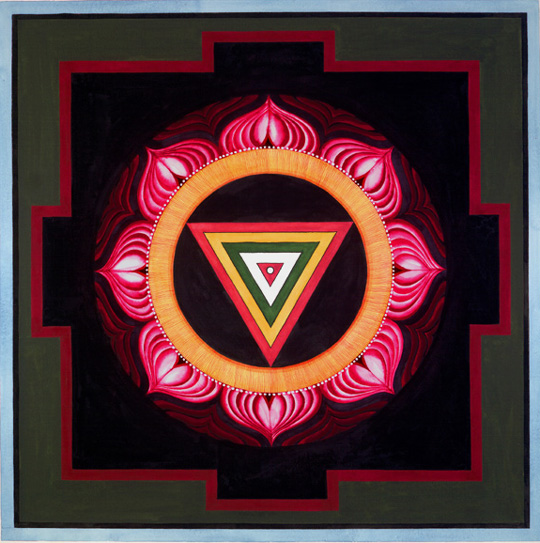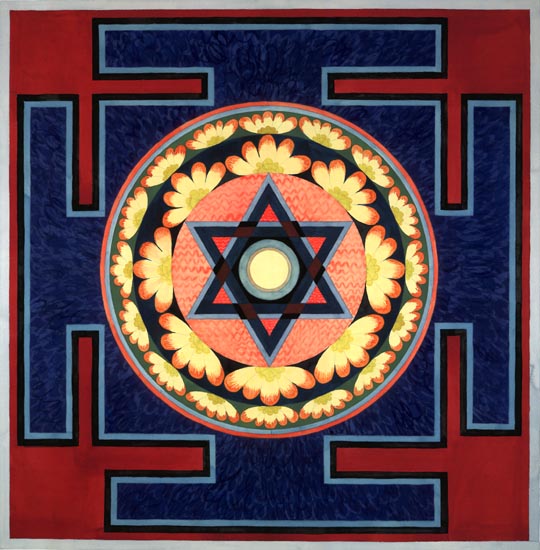Category Archives: Mahavidyas
Kali Yantra
Tripura-sundari Yantra
The third Mahavidya is Tripura-sundari (lovely in the 3 worlds), also known as Sodasi and Lalita among a string of other names. She is the zenith of the creative cycle when the entire universe, like a flower, is in full bloom. She is the chief deity of the Sri Vidya form of worship, and is contacted either in the central circuit of the Sri Yantra, or in her own yantra, the Nava-Yoni Chakra. Her anthropomorphic qualities are brilliancy, manifestation, sweetness, depth, fixity, energy, grace, and generosity.
Tripura Bhairavi
Tripura-Bhairavi (the fierce one in the 3 spheres) comes from before time, can take the form of the sun, and can dissolve the world as fire. She is the consort of Bhairava (a fierce form of Siva). In general, she is not thought of as a consort, but is independent of the gods and transcends them. While she is capable of exciting great passion, she is said to control passion as well. She is revealer and teacher, conferring the power of awakened consciousness that is cultivated in tantric spiritual practice. As all phenomena are in a dance of creation and dissolution, Bhairavi is present everywhere, implicitly offering revelation and awakened consciousness in this context. She is imaged with the crescent moon on her forehead.
Tara Yantra
In Hindu Tantrism, Tara is the second in this sacred circle and is known as the refining fire. She entered the circle of Mahavidyas from Buddhism where she is almost always known as a benevolent deity. In Hindu tantrism Tara is largely known for her fierce manifestations where she is seen as wild, unrestrained and dominant. As the refining fire, she is identified with the destructive but purifying fire that burns enslavement to the ego perspective and thus enables the transition from one form of existence to another.
Matangi Yantra
|
“Little muddy ones, come to me. Encrusted ones, come to me And let me turn your soil into nourishment for your Soul.” |
Daughter of hunter-king, Matanga, and of Buddhist as well as Hindu origin, Matangi’s home is deep within the jungle. She is radiantly dark in color, dressed in red, has the disc of the moon on her forehead and is usually flanked by two parrots. She is of low caste, a Cangala. She is known as “Uccista-matangini”: the bestower of all boons on the unwashed, and asks, in turn, for polluted offerings…. a goddess for our age of pollution and waste. No vows or preparation of any kind are needed to ask for her blessing and the uninitiated are welcome. She offers psychic power and liberation to consciousness bound by social conformity and conventionality. She nourishes the sixty-four arts and plays the vina. One can ask her for poetic talent or any other gift associated with creation. Her name is pronounced Mah-tahng-GI (with a hard G).
This watercolor attempts to bring in the feel of the jungle (which is Her home) to the sacred geometry of the yantra of Matangi.
Kamala Yantra
Kamala, “she of the lotus,” is a name of Laksmi, one of the most popular deities of India. The last of the ten Mahavidyas, and in striking contrast to her powerful presence in popular religious belief, Kamala is considered of least importance yet crucial within this group. She is a source of worldly blessings, abundance, fertility, and growth. In Hindu myth she appears, as does the Greek Aphrodite, from the ocean. As a member of this tantric group, Kamala is described as free from all other male consorts and as having fierce as well as benign attributes and, in her way as both light and shadow, brings abundance to spiritual aspirations.
This watercolor combines the sacred geometry of the yantra of Kamala with a scene derived from a Punjab Hills painting c. 1775.
Dhumavati Yantra
“Oh children come to me, your most ardent desire.
Enter into my soft black certainty
And become Nothing.”

Ash-colored Dhumavati is the divine energy of ultimate destruction. She reduces the world to ashes and everything in the universe then lies inert, unused and “dead.” As a powerful force contra to ego-centered consciousness, her outward manifestations in the world are frightening: despair, dread, poverty, hunger, and misfortune. To the aware, these are all boons. And to her devotees and for those who find themselves alone she is kind and compassionate. Her home is the cremation ground and her mount, the crow.
Chinnamasta Yantra
“Enter into my Chapel,
Accept my calm effulgent light:
The Void of transparency.”
Chinnamasta is said to represent spiritual accomplishment and the control of the up-rush of kundalini power. She probably originated from Tantric Buddhism where she was known as Chinnamunda or as a form of Vajra-Yogini. Her iconography is very powerful. She is shown having decapitated herself while standing with her head in one hand as streams of her life’s blood is nourishing two attendants standing on either side of her. While this seems a violent image, to remove the head is a symbol of the control of the ego-mind with its endless stories and chatter. Thus it can be seen as a powerful aid to spiritual advancement.







